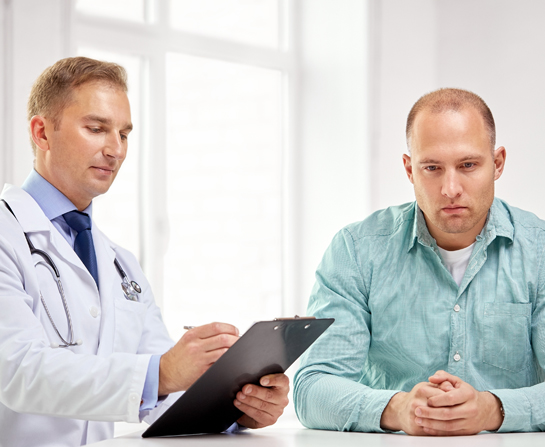A Tumour in the Testicle
April 28, 2022 Return

Assoc Prof Dr Christopher Ho Chee Kong Consultant Urologist and Sexual Medicine Consultant, Beacon International Specialist Centre
Testicular cancer is not very common, but when it does occur, it commonly occurs among men between their 20s and 40s. It can occur at a later age, but that is even rarer. Usually only one testicle is affected, but the cancer may spread to the other testicle and other parts of the body if left untreated.

Risk factors
Consultant urologist and sexual medicine consultant Assoc Prof Dr Christopher Ho points out that we have yet to discover the exact causes of testicular cancer, but among young men, the risk increases if they have a history of undescended testicle (cryptorchidism).
We can’t rely on symptoms to tell us that something is wrong.
Dr Ho explains that, in many cases, most men with early stage testicular cancer do not experience any pain or discomfort. It is only when the cancer has reached an advanced stage that symptoms may be felt. These symptoms include bone pain and jaundice.
Therefore, self-examination is the best “screening” method.
Dr Ho recommends checking one’s testicles in front of a mirror regularly (at least once a month). Some things to watch out for are:
- Appearance of mysterious lumps, nodules or other masses
- Unusual swelling or enlargement of the testicles
It is best to perform this self-examination after having a warm bath, as the heat from the bath would relax the skin of the scrotum, making it easier to detect any signs of abnormalities.
If you detect any abnormalities, see a doctor as soon as possible. If the cancer is diagnosed at an earlier stage, your chances of recovery are significantly higher.
Diagnosing testicular cancer
The doctor will perform some tests to determine whether you have testicular cancer. First, the doctor will physically examine your affected testicle.
Next, an ultrasound test is performed. Dr Ho says that this method allows the doctor to “look” into your testicle to locate and determine the size of the unusual mass. This test is about 90% accurate.
If the presence of a lump is confirmed, the doctor usually recommends the removal of the entire affected testicle. The procedure is called radical inguinal orchiectomy.
According to Dr Ho, this is both a treatment and diagnostic procedure, as the removed testicle will be sent to a laboratory to determine whether the lump is cancerous and, if it is, the type and stage of the cancer.
If you are uncomfortable about your appearance down below after the surgery, Dr Ho mentions that reconstructive surgery is available. This procedure implants a prosthesis into the scrotum, and the prosthesis feels just like a real testicle.
After the surgery
Next, your doctor will determine whether the cancer cells in your testicle have spread to other parts of the body. This is usually done via a computerized tomography (CT) scan. A series of X-ray images of your abdomen, chest and pelvis will be taken. These images will then be analysed for the presence of tumours.
A blood test may also be performed, to check for elevated levels of substances called tumour markers. If the test comes back with abnormally high levels of these substances, there may still be cancer cells in your body.
Follow-up treatments – radiation therapy or chemotherapy, or both – will then be prescribed, based on the stage of your cancer.
Radiation therapy
This is one possible treatment for certain types of testicular cancer (seminoma type). There is a risk of infertility associated with this therapy, so if you wish to have children in the future, you can freeze your sperm first. You can discuss your options with a fertility specialist.
Chemotherapy
For advanced stage testicular cancer, in which the cancer has spread to other parts of the body, chemotherapy will be prescribed. Just as with the chemotherapy drugs used to treat prostate cancer, the chemotherapy drugs for testicular cancer can cause side effects. You will be monitored closely for these side effects, and dosage would be adjusted to reduce their severity. Once treatment is complete, the side effects will go away.
Recovery rate
Dr Ho delivers the good news: compared to other types of cancer, testicular cancer (even at its advanced stage) has a good recovery rate.
For early stage cancer, the cure rate is more than 90%. Even for advanced stage cancer, the survival rate is still pretty good, about 70%. Of course, this is provided that the patient receives proper treatment.
Therefore, if you suspect that there is something abnormal happening to your testicles, it is definitely a good idea to see a doctor as soon as possible!
If you like this article, do subscribe here.
